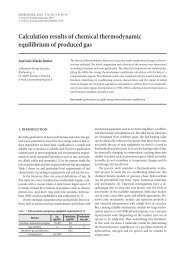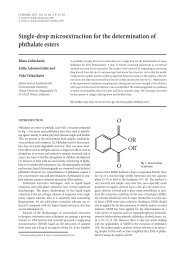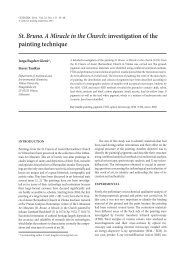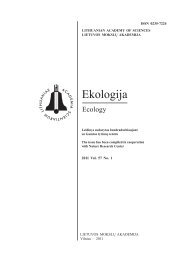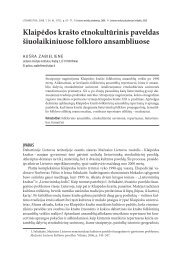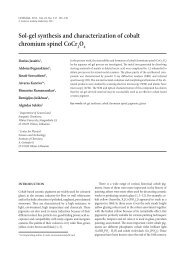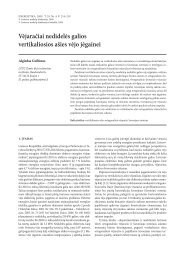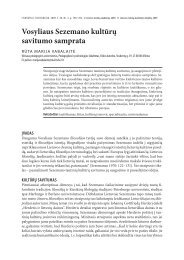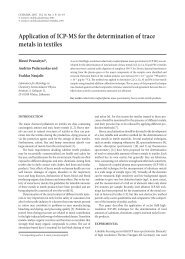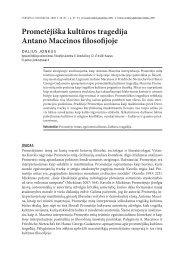Determination of melamine in milk powder by capillary - Lietuvos ...
Determination of melamine in milk powder by capillary - Lietuvos ...
Determination of melamine in milk powder by capillary - Lietuvos ...
You also want an ePaper? Increase the reach of your titles
YUMPU automatically turns print PDFs into web optimized ePapers that Google loves.
<strong>Determ<strong>in</strong>ation</strong> <strong>of</strong> <strong>melam<strong>in</strong>e</strong> <strong>in</strong> <strong>milk</strong> <strong>powder</strong> <strong>by</strong> <strong>capillary</strong> electrophoresis233were obta<strong>in</strong>ed. Based on these results, Tris-phosphate waschosen as a carrier electrolyte. However, due to a very slowelectroosmotic flow (EOF) <strong>in</strong> the acidic electrolyte, the totalrun time (about 7.5 m<strong>in</strong>) was too high for a fast analysis.The rate <strong>of</strong> the EOF strongly depends on the pH <strong>of</strong> theelectrophoresis medium and decreases rapidly below pH 6,result<strong>in</strong>g <strong>in</strong> a longer time <strong>of</strong> analysis. Elim<strong>in</strong>ation <strong>of</strong> the pHdependency<strong>of</strong> the EOF requires a chemical modification <strong>of</strong>the <strong>capillary</strong> surface. The most commonly used approach is abilayer <strong>capillary</strong> coat<strong>in</strong>g [14]. The two-stage process <strong>in</strong>volves<strong>in</strong>itially flush<strong>in</strong>g the <strong>capillary</strong> with electrolyte conta<strong>in</strong><strong>in</strong>gthe polycation. The multiply charged polycations coat theentire <strong>capillary</strong> wall, mak<strong>in</strong>g it strongly positively charged.The <strong>capillary</strong> is then flushed with a buffer conta<strong>in</strong><strong>in</strong>g thepolyanion. The polyanions adsorb to the positively chargedlayer and form a highly negatively charged layer which is<strong>in</strong>sensitive to pH changes, result<strong>in</strong>g <strong>in</strong> a strong and constantcathodal EOF. In the present work, the <strong>capillary</strong> coated witha poly(diallyldimethylammonium) / poly(styrenesulfonate) bilayer was tested for the separation <strong>of</strong> <strong>melam<strong>in</strong>e</strong>. Such<strong>capillary</strong> coat<strong>in</strong>gs have been successfully employed for tomodify EOF velocity <strong>in</strong> CE separation <strong>of</strong> <strong>in</strong>organic ions andorganic molecules [15–18]. The complete <strong>capillary</strong> coat<strong>in</strong>gprotocol is given <strong>in</strong> Experimental. Us<strong>in</strong>g a <strong>capillary</strong> coatedwith a PDDAC / PSS bilayer, the separation time was reducedFig. 3. Effect <strong>of</strong> electrolyte pH on the migration time (a) and peak efficiency (b) <strong>of</strong><strong>melam<strong>in</strong>e</strong>. Electrolyte, 50 mmol/l <strong>of</strong> H 3PO 4neutralized with Tris to desired pHFig. 4. Electropherogram <strong>of</strong> a standard <strong>melam<strong>in</strong>e</strong> solution (10 mg/l) us<strong>in</strong>g a<strong>capillary</strong> coated with poly(diallyldimethylammonium)/poly(styrenesulfonate)bilayer. Electrolyte, 50 mmol/l <strong>of</strong> H 3PO 4neutralized with Tris to pH 2.5. Otherconditions as <strong>in</strong> Fig. 2<strong>by</strong> a factor <strong>of</strong> about 2.4, while the peak efficiency rema<strong>in</strong>edquite satisfactory.In CE, ionic analyte separation is based on both theircharge and size. For a weakly basic MEL (pK a= 5), its mobilityis pH-dependent because the protonation <strong>of</strong> the analyteis controlled <strong>by</strong> electrolyte pH. The effect <strong>of</strong> electrolyte pHon the migration time and peak efficiency (theoretical platenumber, N) <strong>of</strong> MEL is summarized <strong>in</strong> Fig. 3. As expected, dueto the protonation <strong>of</strong> MEL at pH values near and below itspK a, the net charge and, consequently, the mobility <strong>of</strong> MELcation <strong>in</strong>creases, result<strong>in</strong>g <strong>in</strong> a shorter migration time and abetter peak efficiency. The best separation performance wasobserved <strong>in</strong> the pH range 2–3. Tak<strong>in</strong>g the buffer<strong>in</strong>g capacity<strong>in</strong>to account, pH 2.5 was considered to be the best value forthe carrier electrolyte. The electropherogram obta<strong>in</strong>ed underoptimum conditions for a standard MEL solution is shown<strong>in</strong> Fig. 4. As one can see, a significantly better separation performance<strong>in</strong> respect to peak efficiency and separation timewas obta<strong>in</strong>ed for the coated <strong>capillary</strong>.Once the optimized conditions were selected, the methodwas validated with respect to the follow<strong>in</strong>g parameters:l<strong>in</strong>earity <strong>of</strong> the calibration curve, limit <strong>of</strong> detection, limit <strong>of</strong>quantification, precision and accuracy.The l<strong>in</strong>earity <strong>of</strong> the method was tested <strong>by</strong> prepar<strong>in</strong>g a calibrationcurve for each analyte with six po<strong>in</strong>ts. The test concentrationrange was 0.2 to 10 mg/l, and each concentrationlevel was <strong>in</strong>jected (12 s) three times. The assay showed a l<strong>in</strong>earitywith a relative standard deviation (RSD) ≤4.1% for therelative responses (peak area divided <strong>by</strong> concentration) obta<strong>in</strong>ed<strong>in</strong> the concentration range tested and the correlationcoefficient >0.9997 found for both analytes. The <strong>in</strong>tercept



